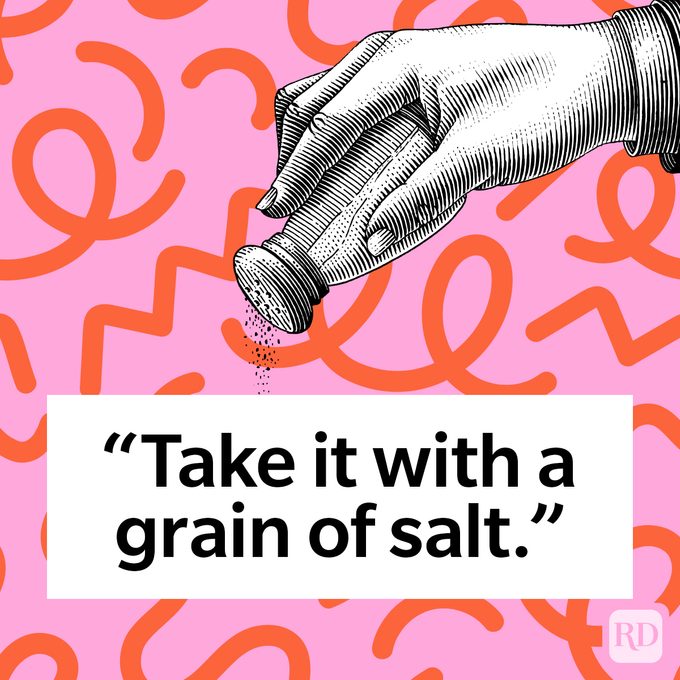The answer is a mix of history and language evolution with a dash of mystery. Here, two language historians break down the origin of take it with a grain of salt.

Where Did the Phrase “Take It with a Grain of Salt” Come From?

If you’ve shared information you weren’t entirely sure was true, you’ve probably told your audience to “take it with a grain of salt.” This ancient idiom has been around for so long that most of us can’t trace its roots—or explain why on earth we’re talking about salt.
To get to the bottom of it, I spoke to two language historians. Read on for the lowdown on this everyday idiom, including why we use it and where it came from. By the end, you’ll be better informed … and well-seasoned.
Get Reader’s Digest’s Read Up newsletter for more word history, humor, travel, tech and fun facts all week long.
What does take it with a grain of salt mean?
The Oxford English Dictionary (OED) defines take it with a grain of salt as “to accept a statement with a certain amount of reserve.”
When you use this phrase, you’re encouraging someone to consider the information with caution, rather than accept it at face value. We do this when we’re not certain about the information or advice we’re providing—we’re essentially saying, “But hey, stay skeptical.”
What are some examples of how to use this phrase?
Want to remind others to be wary? Here are a handful of ways to do so:
- “Sure, these initial numbers look promising, but we should take them with a grain of salt until we see the full sales report.”
- “That ‘miracle diet’ sounds too good to be true—take your wellness instructor’s advice with a grain of salt.”
- “The weatherman said it’s not supposed to rain today, but I’d take that with a grain of salt and bring an umbrella anyway.”
- “TMZ says the ‘it’ couple is engaged, but take it with a grain of salt until they make it Insta official.”
- “I’d leave that toxic workplace and find a new job. I’m not a therapist, though, so take that advice with a grain of salt.”
- “My aunt swears by this magic remedy for the flu. I’d take it with a grain of salt—and maybe some actual medicine.”
- “Early online reviews of that app are great, but I bet they’re from company employees, so I’d take them with a grain of salt.”
What is the origin of this phrase?

The meaning of this phrase has evolved over the years, but its roots go all the way back to the Roman Empire. Ahead, we’re laying out the origin and modern use of the common idiom.
The ancient meaning
In his book Natural History (written around 77 C.E.), Pliny the Elder relayed the story of how Gen. Pompey found directions for the concoction that King Mithridates VI had used to inoculate himself against certain poisons:
Take two dried walnuts, two figs and twenty leaves of rue; pound them all together, with the addition of a grain of salt; if a person takes this mixture fasting, he will be proof against all poisons for that day.
This account suggests that salt would make the antidote easier to swallow. Pliny used the Latin phrase addito salis grano (“after having added a grain of salt”), but with the grammar construction of modern European languages, that became cum grano salis (“with a grain of salt”). According to Michael Adams, PhD, a professor of English and linguistics at Indiana University, “that Latin phrase, cum grano salis, is used all over the place” in ancient texts, “until it finally gets translated into English.”
The modern meaning
Per the OED, the first usage of the phrase take it with a grain of salt in its figurative (rather than literal) meaning was recorded in 1647. But how did we get from Pliny’s usage to the idiom’s current meaning of being skeptical?
It’s possible our ancestors thought the idea of using salt to make poison easier to swallow was an apt description for employing a little caution when consuming questionable information. But “it’s tough to make a direct connection,” says Laurel Brinton, PhD, professor emerita at the University of British Columbia in Vancouver, Canada.
Still, there is a connection. During the Renaissance, she says, “they were very interested in [the classics], and they revived all of these classical or semiclassical texts. So they might have read Pliny the Elder” and rediscovered the phrase.
Though the OED notes two recorded uses of take it with a grain of salt in the 17th century, after that, the phrase seems to disappear until the late 19th century. So why did it come back into fashion? “I don’t think we really know why certain expressions become standard and others just fall away,” Brinton says. “It probably has to do with who uses it, how influential these people are who use it and, you know, how widely it’s accepted and used.”
Why is it just one grain of salt?
As for why the idiom references just a single grain of salt, “You’d have to ask Pliny,” Adams jokes. But since a variation of this idiom is to take it with a pinch of salt, he believes that other people must have asked this question before. “Surely it would take more salt than that,” he says, “not just one grain of skepticism but a whole pinch.”
There’s another possible path from Pliny’s grain of salt to this variation. “We often use a pinch of salt in cooking, and so pinch of salt got substituted for grain of salt here,” Adams says. “For some people, that’s called a mistake. For other people, that’s just a development in the way people use the phrase.”
What are some synonyms for this phrase?
Here are a dozen other ways to remind someone to take information with a grain (or a pinch) of salt.
- Believe it when you see it.
- Consider the source.
- Don’t believe everything you hear.
- Don’t buy it hook, line and sinker.
- Don’t take it as gospel.
- Don’t take it at face value.
- Don’t take it to the bank.
- Not everything is as it seems.
- Read between the lines.
- Sounds too good to be true.
- Take it lightly.
- There’s more than meets the eye.
So the next time you hear something that sounds a little too good to be true, just remember: Whether the tip is taken with a grain of salt or a whole pinch, being a little skeptical doesn’t hurt.
About the experts
|
Why trust us
At Reader’s Digest, we’re committed to producing high-quality content by writers with expertise and experience in their field in consultation with relevant, qualified experts. We rely on reputable primary sources, including government and professional organizations and academic institutions as well as our writers’ personal experience where appropriate. We verify all facts and data, back them with credible sourcing and revisit them over time to ensure they remain accurate and up to date. For this piece on take it with a grain of salt‘s meaning, Jo Ann Liguori tapped her decades of experience as a copy editor to ensure that all information is accurate and offers the best possible advice to readers. Read more about our team, our contributors and our editorial policies.
Sources:
- Michael Adams, professor of English and linguistics at Indiana University Bloomington; phone interview, Jan. 31, 2025
- Laurel Brinton, professor emerita of English historical and contemporary linguistics at the University of British Columbia in Vancouver, Canada; phone interview, Jan. 31, 2025
- Oxford English Dictionary: “Salt”
- University of Chicago: “Pliny the Elder’s Natural History — Book 7”
- World Wide Words: “Pinch of Salt”























